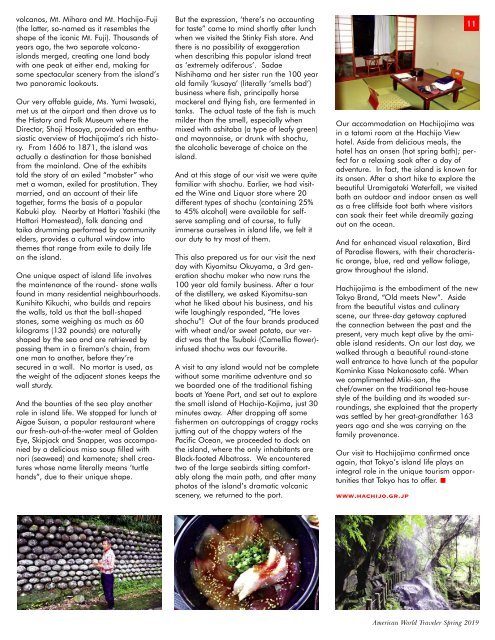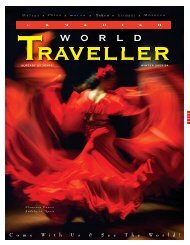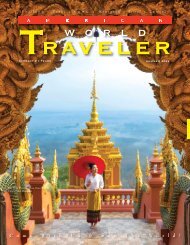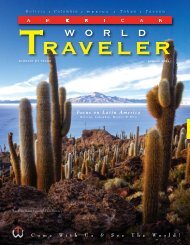American World Traveler Spring 2019 Issue
Now in our 17th year of publishing, American World Traveler explores the culture and history of worldwide destinations, sharing the adventure of discovery with our readers and motivating them to make their travel dreams a reality. Published quarterly, AWT helps sophisticated, independent American travelers choose their next destination by offering a lively blend of intelligent, informative articles and tantalizing photographic images from our World’s best destinations, cruises, accommodations and activities to suit every traveler's taste.
Now in our 17th year of publishing, American World Traveler explores the culture and history of worldwide destinations, sharing the adventure of discovery with our readers and motivating them to make their travel dreams a reality. Published quarterly, AWT helps sophisticated, independent American travelers choose their next destination by offering a lively blend of intelligent, informative articles and tantalizing photographic images from our World’s best destinations, cruises, accommodations and activities to suit every traveler's taste.
Create successful ePaper yourself
Turn your PDF publications into a flip-book with our unique Google optimized e-Paper software.
volcanos, Mt. Mihara and Mt. Hachijo-Fuji<br />
(the latter, so-named as it resembles the<br />
shape of the iconic Mt. Fuji). Thousands of<br />
years ago, the two separate volcanoislands<br />
merged, creating one land body<br />
with one peak at either end, making for<br />
some spectacular scenery from the island’s<br />
two panoramic lookouts.<br />
Our very affable guide, Ms. Yumi Iwasaki,<br />
met us at the airport and then drove us to<br />
the History and Folk Museum where the<br />
Director, Shoji Hosoya, provided an enthusiastic<br />
overview of Hachijojima’s rich history.<br />
From 1606 to 1871, the island was<br />
actually a destination for those banished<br />
from the mainland. One of the exhibits<br />
told the story of an exiled “mobster” who<br />
met a woman, exiled for prostitution. They<br />
married, and an account of their life<br />
together, forms the basis of a popular<br />
Kabuki play. Nearby at Hattori Yashiki (the<br />
Hattori Homestead), folk dancing and<br />
taiko drumming performed by community<br />
elders, provides a cultural window into<br />
themes that range from exile to daily life<br />
on the island.<br />
One unique aspect of island life involves<br />
the maintenance of the round- stone walls<br />
found in many residential neighbourhoods.<br />
Kunihito Kikuchi, who builds and repairs<br />
the walls, told us that the ball-shaped<br />
stones, some weighing as much as 60<br />
kilograms (132 pounds) are naturally<br />
shaped by the sea and are retrieved by<br />
passing them in a fireman’s chain, from<br />
one man to another, before they’re<br />
secured in a wall. No mortar is used, as<br />
the weight of the adjacent stones keeps the<br />
wall sturdy.<br />
And the bounties of the sea play another<br />
role in island life. We stopped for lunch at<br />
Aigae Suisan, a popular restaurant where<br />
our fresh-out-of-the-water meal of Golden<br />
Eye, Skipjack and Snapper, was accompanied<br />
by a delicious miso soup filled with<br />
nori (seaweed) and kamenote; shell creatures<br />
whose name literally means ‘turtle<br />
hands”, due to their unique shape.<br />
But the expression, ‘there’s no accounting<br />
for taste” came to mind shortly after lunch<br />
when we visited the Stinky Fish store. And<br />
there is no possibility of exaggeration<br />
when describing this popular island treat<br />
as ‘extremely odiferous’. Sadae<br />
Nishihama and her sister run the 100 year<br />
old family ‘kusaya’ (literally ‘smells bad’)<br />
business where fish, principally horse<br />
mackerel and flying fish, are fermented in<br />
tanks. The actual taste of the fish is much<br />
milder than the smell, especially when<br />
mixed with ashitaba (a type of leafy green)<br />
and mayonnaise, or drunk with shochu,<br />
the alcoholic beverage of choice on the<br />
island.<br />
And at this stage of our visit we were quite<br />
familiar with shochu. Earlier, we had visited<br />
the Wine and Liquor store where 20<br />
different types of shochu (containing 25%<br />
to 45% alcohol) were available for selfserve<br />
sampling and of course, to fully<br />
immerse ourselves in island life, we felt it<br />
our duty to try most of them.<br />
This also prepared us for our visit the next<br />
day with Kiyomitsu Okuyama, a 3rd generation<br />
shochu maker who now runs the<br />
100 year old family business. After a tour<br />
of the distillery, we asked Kiyomitsu-san<br />
what he liked about his business, and his<br />
wife laughingly responded, “He loves<br />
shochu”! Out of the four brands produced<br />
with wheat and/or sweet potato, our verdict<br />
was that the Tsubaki (Camellia flower)-<br />
infused shochu was our favourite.<br />
A visit to any island would not be complete<br />
without some maritime adventure and so<br />
we boarded one of the traditional fishing<br />
boats at Yaene Port, and set out to explore<br />
the small island of Hachijo-Kojima, just 30<br />
minutes away. After dropping off some<br />
fishermen on outcroppings of craggy rocks<br />
jutting out of the choppy waters of the<br />
Pacific Ocean, we proceeded to dock on<br />
the island, where the only inhabitants are<br />
Black-footed Albatross. We encountered<br />
two of the large seabirds sitting comfortably<br />
along the main path, and after many<br />
photos of the island’s dramatic volcanic<br />
scenery, we returned to the port.<br />
Our accommodation on Hachijojima was<br />
in a tatami room at the Hachijo View<br />
hotel. Aside from delicious meals, the<br />
hotel has an onsen (hot spring bath); perfect<br />
for a relaxing soak after a day of<br />
adventure. In fact, the island is known for<br />
its onsen. After a short hike to explore the<br />
beautiful Uramigataki Waterfall, we visited<br />
both an outdoor and indoor onsen as well<br />
as a free cliffside foot bath where visitors<br />
can soak their feet while dreamily gazing<br />
out on the ocean.<br />
And for enhanced visual relaxation, Bird<br />
of Paradise flowers, with their characteristic<br />
orange, blue, red and yellow foliage,<br />
grow throughout the island.<br />
Hachijojima is the embodiment of the new<br />
Tokyo Brand, “Old meets New”. Aside<br />
from the beautiful vistas and culinary<br />
scene, our three-day getaway captured<br />
the connection between the past and the<br />
present, very much kept alive by the amiable<br />
island residents. On our last day, we<br />
walked through a beautiful round-stone<br />
wall entrance to have lunch at the popular<br />
Kominka Kissa Nakanosato café. When<br />
we complimented Miki-san, the<br />
chef/owner on the traditional tea-house<br />
style of the building and its wooded surroundings,<br />
she explained that the property<br />
was settled by her great-grandfather 163<br />
years ago and she was carrying on the<br />
family provenance.<br />
Our visit to Hachijojima confirmed once<br />
again, that Tokyo’s island life plays an<br />
integral role in the unique tourism opportunities<br />
that Tokyo has to offer.<br />
www.hachijo.gr.jp<br />
11<br />
<strong>American</strong> <strong>World</strong> <strong>Traveler</strong> <strong>Spring</strong> <strong>2019</strong>
















